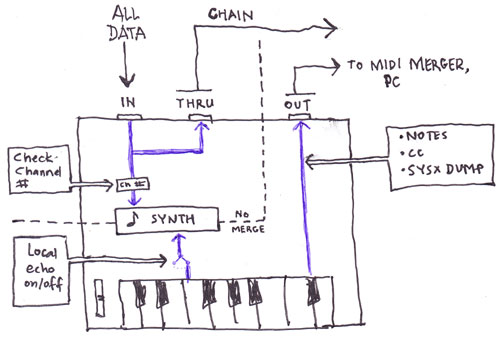
 |
synth path | midi path | MIDI-DIN-FSK sync | sysx | midi to din
The connections of MIDI IN-OUT-THRU
The keyboard and the internal synthesizer can be regarded as 2 totally separate units.
- the keyboard and the knobs are connected to the MIDI OUT,
- the synthesizer and the MIDI THRU are connected to the MIDI IN,
- when "local echo" is turned on, the keyboard controls the synthesizer (internally).
When "local echo" is turned off, the synth and the keyboard really are two separate units together in one box, they cannot even talk to each other. You would have to connect the MIDI OUT to the MIDI IN with a cable to be able to play the synth.
 |
MIDI IN MIDI THRU MIDI OUT Devices that lack the ability to generate MIDI data, such as effect units and sound modules, may not include MIDI OUT ports. |
Synthesizer - and the Splitter
The MIDI THRU is a nice kind of "signal splitter" function: one signal to the synth, and one to the THRU port.
Synthesizers that lack a THRU port, do not split the signal. They keep the signal to themselves without sharing. So this breaks the "chaining" possibilities to other units. Luckily, this can be solved with a "MIDI Splitter" unit, that splits the signal from a 1-in to a 4-out. In the process, the MIDI signal keeps its strength because the unit also amplifies the 1-in to the 4-out. Compare it to a microphone that is connected to an amplifier that drives 4 speakers.
Keyboard - and the Merger
In a setup there can be multiple units that generate MIDI OUT data, like a keyboard, a control surface, a sequencer that sends timing data to synchronise with other sequencers in the chain. Also, computers usually only have 1 MIDI IN port to connect a keyboard to. So these 3 MIDI OUT signals have to be Merged into 1 MIDI OUT first. A "MIDI Merger" unit does the trick. This type of unit primarily avoids collision of the signals. Compare it to a 4 lane road that merges into a 1 lane road.
Timing lag
The only drawback of chaining is the lag. The longer the cables and the more "intermediate stations" in the chain, the greater the lag, until the point you start noticing that the timing of synthesizers further up in the chain is "off". They just sound too late. Try to split the signal as soon as possible.